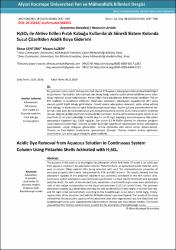H2SO4 ile aktive edilen fıstık kabuğu kullanılarak sürekli sistem kolonda sucul çözeltiden asidik boya giderimi
Citation
Şentürk, İ. & Alzeın, M. (2019). H2SO4 ile Aktive Edilen Fıstık Kabuğu Kullanılarak Sürekli Sistem Kolonda Sucul Çözeltiden Asidik Boya Giderimi . Afyon Kocatepe Üniversitesi Fen Ve Mühendislik Bilimleri Dergisi , 19 (3) , 697-708 . DOI: 10.35414/akufemubid.568263Abstract
Bu çalışmanın amacı asidik bir boya olan Asit Viyolet 17 boyasının adsorpsiyon kolonunda arıtılabilirliğini araştırmaktır. Tarımsal bir atık materyal olan Antep fıstığı kabukları asitle aktive edildikten sonra kolon dolgu materyali olarak kullanılmıştır. Aktive edilen fıstık kabuklarının fizikokimyasal özellikleri FTIR ve BET analizleri ile karakterize edilmiştir. Hazırlanan adsorbanın adsorpsiyon kapasitesinin, BET yüzey alanıyla pozitif ilişkili olduğu görülmüştür. Sürekli sistem adsorpsiyon deneyleri, asitle aktive edilmiş fıstık kabuğu ile doldurulan bir sabit kolonda gerçekleştirilmiştir. Seçilen çalışma parametrelerinin her biri için, çıkış suyu konsantrasyonunun giriş konsantrasyonuna oranına (Ct/Ci) karşılık belirli sürelerde okunan değerler grafiğe geçirilerek kırılma eğrileri çizilmiştir. Kırılma eğrisi verilerine göre seçilen en iyi koşullarda (2 cm yatak yüksekliği, 6 mL/dk akış hızı ve 40 mg/L başlangıç konsantrasyonu) elde edilen adsorpsiyon kapasitesi (qm) 13,66 mg/g’dır. Son olarak 0,2 M NaOH çözeltisi ile adsorban yatağının rejenerasyonu incelenmiştir. Çalışma sonuçları kullanılan adsorbanın rejenerasyon sonrası adsorplama kapasitesinin, düşük olduğunu göstermiştir. Kırılma eğrisinden elde edilen veriler Adams-Bohart, Thomas ve Yoon-Nelson modellerine uyarlanmıştır. Sonuçlar Thomas modelin kırılma eğrilerinin tanımlanması için daha uygun olduğunu göstermektedir. The purpose of this work is to investigate the adsorption of the Acid Violet 17 which is an acidic dye from aqueous solution in the adsorption column. Pistachio shells, an agricultural waste material, were used as column filling material after being activated with acid. The physicochemical properties of activated pistachio shells were characterized by FTIR and BET analysis. The results showed that the adsorption capacity of the prepared adsorbent was positively correlated to the BET surface area. Continuous system adsorption experiments were performed in a fixed column filled with acid-activated pistachio shells. For each of the selected study parameters, the breakthrough curves were plotted as a ratio of the output concentration to the input concentration (Ct/Ci) at certain times. The optimum adsorption capacity (qm) obtained in selecting the best conditions (2 cm bed height, 6 mL/min flow rate, and 40 mg/L initial concentration) according to the breakthrough curve data is 13.66 mg/g. Finally, regeneration of the adsorbent bed with 0.2 M NaOH solution was investigated. The results of the study showed that the adsorption capacity of the adsorbent used after regeneration was low. Data from the breakthrough curves were adapted to the Adams-Bohart, Thomas and Yoon-Nelson models. The results showed that the Thomas model is more suitable for the description of breakthrough curves.
Source
Fen ve Mühendislik Bilimleri DergisiVolume
19Issue
3Collections
- Cilt 19 : Sayı 3 [48]



















